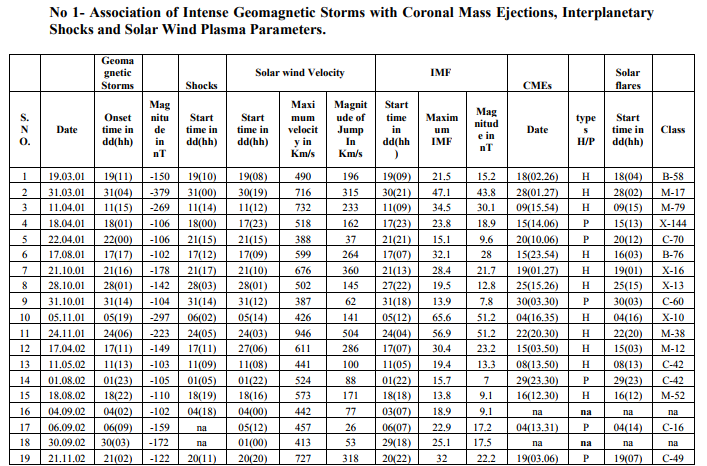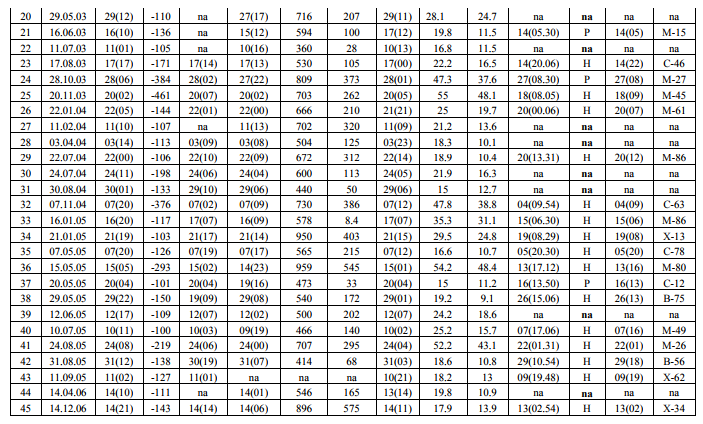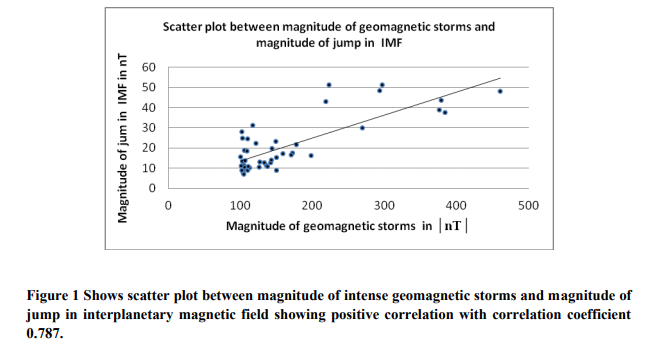IJCRR - 4(7), April, 2012
Pages: 65-77
Date of Publication: 18-Apr-2012
Print Article
Download XML Download PDF
CORONAL MASS EJECTIONS, STORMS IN SOLAR WIND PLASMA PARAMETERS IN RELATION WITH INTENSE GEOMAGNETIC STORMS
Author: P.L. Verma
Category: General Sciences
Abstract:Coronal mass ejections (CMEs) are the most energetic solar events in which large amount of solar plasma materials are ejected from the sun into heliosphere and are widely recognized as being responsible to generate disturbances in solar wind plasma parameters, interplanetary shocks and intense geomagnetic storms in the magnetosphere of the earth. I have studied intense geomagnetic storms (Dst ? - 100nT) observed during the period of 2001-2006, with halo and partial halo coronal mass ejections associated with X-ray solar flares and interplanetary shocks which are interplanetary manifestations of coronal mass ejections. I have found that 77.78% intense geomagnetic storms are associated with halo and partial halo coronal mass ejections. The association rate of intense geomagnetic storms with halo and partial halo
coronal mass ejections are found 74.29% and 25.71% respectively. Further I have observed that intense geomagnetic storms which are associated with coronal mass ejections are also associated with X ray solar flares of different categories. The association rate of B-class, C-class, M-class and X-class X-ray solar flares are found 11.43%, 28.57%, 40.00%, and 20.00% respectively. From the study of intense geomagnetic storms with storms in solar wind plasma parameters, I have determined positive co-relation between magnitude of intense geomagnetic storms and peak values and magnitude of associated storm in solar wind plasma parameters with co-relation co-efficient 0.42 between magnitude of intense geomagnetic storms and peak values of associated storms in solar wind plasma velocity, 0.41 between magnitude of intense geomagnetic storms and magnitude of associated storms in solar wind plasma velocity , 0.792 between magnitude of intense geomagnetic storms and peak values of associated storms in interplanetary magnetic field, 0.787 between magnitude of intense geomagnetic storms and magnitude of associated storms in interplanetary magnetic field. Positive co-relation has also been found between magnitude of IMF and magnitude of solar wind velocity with correlation coefficient 0.54 and 0.53 between Maximum IMF and maximum solar wind velocity.
Keywords: Intense Geomagnetic Storms. Halo and Partial Halo Coronal Mass Ejections. Interplanetary Shocks, Storms in Solar Wind Plasma Parameters.
Full Text:
INTRODUCTION Geomagnetic storms are the significant perturbations of the earth‘s magnetosphere that occur when the interplanetary magnetic field (IMF) turns southward (Bz classes of geomagnetic storms [3] recurrent and non recurrent have been studied by Londi and Moreno [4] with coronal mass ejections and they have concluded that CMEs which are associated with enhanced solar soft X ray emission, are responsible for large fraction of geomagnetic storms. Crooker and Cliver [5] have concluded that the non-recurrent geomagnetic storms are caused by coronal mass ejections and coronal holes / streamer, ensemble. I.G. Richardson et al [6] have determined that intense geomagnetic activity often associated with CME related structure and intense geomagnetic storms are produced by Coronal Mass Ejection at any stage of the solar cycle. Lyatsky and Tan. [7] have studied geomagnetic storms with disturbances in solar wind plasma parameters. They have concluded that the averaged disturbances in solar wind, responsible for generating geomagnetic storms, are associated with compression of ambient solar wind plasma and interplanetary magnetic field ahead of a high speed plasma flow. The magnetic field strength and plasma density start to increase, several hours before geomagnetic storm onset; however, the negative IMFBz start to increase approximately 4or 5 hours after the maximum variation in plasma and IMF By. Michalek and Gopalswamy et al [8] have concluded that only fast halo CMEs with space velocity higher than 1000 km/s and originating from the western hemisphere close to the solar center could cause intense geomagnetic storms. Magnetic clouds, interplanetary shocks, ejecta are the interplanetary manifestations of coronal mass ejections. Zhang and Burlaga [9] have studied geomagnetic storms with magnetic clouds and found that magnetic clouds can produce geomagnetic storms with the larger storms being associated with shock related clouds. The time of onset of the geomagnetic activity coincides with the arrival of magnetic clouds when the magnetic field is oriented southward at the cloud onset and it occurs later during the cloud when the magnetic field is oriented northward at the cloud onset.Richardson.et al. [10] have investigated geomagnetic storm with coronal mass ejections, they have determined that Intense geomagnetic storm are produced by coronal mass ejections at any stage of solar cycle. Shrivastava [11] has examined the solar origin of the geoeffective CMEs and their interplanetary effects, namely, solar wind speed, interplanetary shocks and the southward component of the interplanetary parameters. They have found that full halo CMEs associated with strong flares and originating from a favorable location, i.e. close to the central meridian and low and middle latitudes, are the most potential candidates for producing strong ram pressure at the earth‘s magnetosphere and hence intense geomagnetic storms. Gopalswamy et al [12] have studied geoeffectiveness, speed, solar source and flare association of a set of 378 halo coronal mass ejections (HCMEs) of solar cycle 23 (1996- 2005). They have found that the disk halos are followed by strong geomagnetic storms, limb halos are followed by moderate storms and back side halos are not followed by significant storms. They have concluded that disk halos and limb halos CMEs are very much effective in producing geomagnetic storms. Verma et al [13] have studied geomagnetic storms Dst < - 50nT observed during the period of 1997- 2006, with halo and partial halo coronal mass ejections associated with X-ray solar flares of different categories and concluded that halo and partial halo CMEs associated with X ray solar flares are most potential candidates for production of geomagnetic storms. In this investigation I have studied intense geomagnetic storms observed during the period of 2001to 2006 with coronal mass ejections and disturbances in solar wind plasma parameters (solar wind plasma velocity and interplanetary magnetic field ) to know the real cause of intense geomagnetic storms . Data and Analysis In this investigation hourly Dst indices of geomagnetic field have been used over the period 2001 to 2006 to determine onset time, maximum depression time, and magnitude of geomagnetic storms. This data has been taken from the NSSDC omni web data system which has been created in late 1994 for enhanced access to the near earth solar wind, magnetic field and plasma data of omni data set, which consists of one hour resolution near earth, solar wind magnetic field and plasma data, energetic proton fluxes and geomagnetic and solar activity indices. The data of CMEs and shocks have been taken from the list of shocks derived by PM/MTOF group from the SOHO observations, shocks arrival derived by the IPS group from ACE observations, shock arrival derived by WIND group from WIND observations SOHO, LASCO, CME catalogue which consists all CMEs manually identified since 1996 from large angle and spectrometric coronagraph(LASCO)onboardard(SOHO) (http://umtof.edu/pm/shocks.html,www.lmsal.c om/cgidiaposon/www_getcme_list_sh,htpp://p wg.gsfc.nasa.gov/wind/current_listIPS.html). The solar wind plasma parameter data has also been taken from NSSDC omni web data system


RESULTS
The association between intense geomagnetic storms (Dst < –100nT) and coronal mass ejections (CMEs), interplanetary shocks and disturbances in solar wind plasma parameters for the period 2001to 2006 are given in Table No.1. From the data analysis it is observed that 35 out of 45 (77.78%) intense geomagnetic storms are found to be associated with halo and partial halo coronal mass ejections. The association rate of halo and partial halo coronal mass ejections have been found 74.29 and 25.71% respectively. We have also determined that the coronal mass ejections, which are related to intense geomagnetic storms, are also related to the Xray solar flares of different categories. Out of 35 associated CMEs, 07 (20.00%) are related with X-class, 14 (40.00%) are related with Mclass, 10 (28.57%) are

Geomagnetic storm observed on 31.03.01
Onset time 31(04) in dd(hh) and magnitude, -379 nT, Shocks- Start time 31(00) in dd(hh). CMEs- Start time 28 (01.27) in dd(hh) and type- H. Solar flare- Start time28 (02) in dd(hh) and Class- M-17. Maximum jump in Geomagnetic storm observed on 11.04.01 Onset time 11(15) in dd(hh) and magnitude, -269 nT. Shocks- Start time 11(14) in dd(hh). CMEs- Start time 09 (15.54) in dd(hh) and type- H. Solar flare- Start time09 (15) in dd(hh) and Class- M-79. Maximum jump in solar wind velocity= 732km/s Magnitude of jump in solar wind velocity = 233km/s Maximum jump in IMF =34.5nT Magnitude of jump in IMF= 30.1nT.
Geomagnetic storm observed on 05.11.01
Onset time 05(19) in dd(hh) and magnitude= -297 nT. Shocks- Start time 06(02) in dd(hh). CMEs- Start time 04 (16.35) in dd(hh) and type- H. Solar flare- Start time04 (16) in dd(hh) and Class- X-10. Maximum velocity Geomagnetic storm observed on 24.11.01 Onset time 24(06) in dd(hh) and magnitude -223 nT. Shocks- Start time 24(05) in dd(hh). CMEs- Start time 22 (20.30) in dd(hh) and type- H. Solar flare- Start time22 (20) in dd(hh) and Class- M-38. Maximum jump in solar wind velocity velocity= 946km/s. Magnitudeof jump in solar wind velocity =504km/s. Maximum jump in IMF =56.9 nT. Magnitude of jump in IMF= 51.2nT.
Geomagnetic storm observed on 28.10.03
Onset time 28(06) in dd(hh) and magnitude, -384 nT. Shocks- Start time 28(02) in dd(hh). CMEs- Start time 27 (08.30) in dd(hh) and type- P. Solar flare- Start time 27 (08) in dd(hh) and Class- M-27. Maximum jump in
Geomagnetic storm observed on 20.11.03
Onset time 20(02) in dd(hh) and magnitude, -461 nT. Shocks- Start time 20(07) in dd(hh). CMEs- Start time 18 (08.05) in dd(hh) and type- H. Solar flare- Start time 18 (09) in dd(hh) and Class- M-45. Maximum jump in solar wind velocity=703km/s Magnitudeof jump in solar wind velocity =262km/s. Maximum jump in IMF= 55nT. Magnitudeof jump in IMF =48.1nT.
Geomagnetic storm observed on 07.11.04
Onset time 07(20) in dd(hh) and magnitude, -376 nT. Shocks- Start time 07(02) in dd(hh). CMEs- Start time 04 (09.54) in dd(hh) and type- H. Solar flare- Start time 04 (09) in dd(hh) and Class- C-63. Maximum jump in solar wind velocity =730km/s Magnitude of jump in solar wind velocity =386km/s. Maximum jump in IMF =47.8nT. Magnitude of jump in IMF =38.8nT.
Geomagnetic storm observed on 15.05.05
Onset time 15(05) in dd(hh) and magnitude, -293 nT. Shocks- Start time 15(02) in dd(hh). CMEs- Start time 13 (17.12) in dd(hh) and type- H. Solar flare- Start time 13 (16) in dd(hh) and Class- M-80. Maximum in solar wind velocity= 959km/s Magnitudeof jump in solar wind velocity =545km/s. Maximum jump in IMF =54.2nT. Magnitude of jump in IMF =48.4nT.
Geomagnetic storm observed on 24.08.05
Onset time 24(08) in dd(hh) and magnitude , -219 nT. Shocks- Start time 24(06) in dd(hh). CMEs- Start time 22 (01.31) in dd(hh) and type- H. Solar flare- Start time 22 (01) in dd(hh) and Class- M-26. Maximum jump in
found to be related with C-class and 04 (11.43%) are found to be associated with B class X-ray solar flares. From further analysis it is observed that majority of these intense geomagnetic storms are also related to the interplanetary shocks and the related shocks are forward shocks. I have 45 intense geomagnetic storms in our list in which 38 intense geomagnetic storms (84.44%) have been found to be associated with interplanetary shocks. From the study of intense geomagnetic storms with solar wind plasma parameters i.e. Jump in solar wind velocity (JSWV) and jump in interplanetary magnetic field we have determined positive co-relation between magnitude of intense geomagnetic storms and peak values and magnitude of associated storm in solar wind plasma parameters with corelation co-efficient 0.42 between magnitude of intense geomagnetic storms and peak values of associated storms in solar wind plasma velocity, 0.41 between magnitude of intense geomagnetic storms and magnitude of associated storms in solar wind plasma velocity , 0.792 between magnitude of intense geomagnetic storms and peak values of associated storms in interplanetary magnetic field, 0.787 between magnitude of intense geomagnetic storms and magnitude of associated storms in interplanetary magnetic field. From the study of disturbances in solar wind velocity and interplanetary magnetic field, it is observed that these two parameters are closely related. We have found positive correlation between magnitude of jump in solar wind velocity and magnitude of jump in interplanetary magnetic field with correlation coefficient 0.54 between these two events. Positive correlation has also been found between peak value of solar wind velocity and peak value of interplanetary magnetic field with correlation coefficient 0.53 between these two events. Further I have analyzed all the intense geomagnetic storms having storm magnitude ≤-200nT (severe geomagnetic storms) and the results are shown with the figure 7-15. From the analysis of severe geomagnetic storms .I have observed that all the geomagnetic storms are associated with halo and partial halo coronal mass ejections. The association rates of halo and partial halo coronal mass ejections have been found 88.88% and 11.12% respectively. Further these CMEs have been found to be related with XRay solar flares .All severe geomagnetic storms have been found to be associated with interplanetary shocks. I have also observed that all severe geomagnetic storms are associated with higher jump and peak values of associated disturbances in solar wind plasma parameters.
CONCLUSION
From our study 35 out of 45 intense geomagnetic storms < -100nT have been identified as being associated with coronal mass ejections and 90% of them are related to X-ray solar flares (CMEs). 38 out of 45 (84.44%) are identified as being associated with interplanetary shocks. These results are suggesting that the X-ray solar flares related coronal mass ejections associated with shocks is very much effective in producing major geomagnetic storms. The positive correlation between magnitude of intense geomagnetic storms and peak values and magnitude of solar wind velocity and interplanetary magnetic fields suggest that disturbances in solar wind parameters play crucial role in producing intense geomagnetic storms. Positive corelation between magnitude of IMF and magnitude of solar wind velocity and peak value of interplanetary magnetic field and peak value of interplanetary magnetic field suggesting that intense geomagnetic storms ,disturbances in interplanetary magnetic field and solar wind velocity are closely related . Further I have inferred that geomagnetic storms Dst < - 200 nT which are defined as severe geomagnetic storms are associated with higher jump and peak values of associated disturbances in solar wind plasma parameters including interplanetary magnetic field and interplanetary shocks .All severe geomagnetic storms are associated with X-ray solar flares .It is concluded that the severe geomagnetic storms are caused by coronal mass ejections associated with X –ray ray solar flares and related to interplanetary shocks .
ACKNOWLEDGEMENT
The author would like to thank Prof. P.K Shukla, S.K.Nigam and B.P.Chandra for valuable suggestions. The author is grateful to OMNIWEB and SOHO data group whose data have been used in this study.
References:
1. Gonzalez W.D. and B.T. Tsurutani planet, space sci. 35, 1101, 1987
2. Gonzalez W.D, J. Geophys Res. 99, 5771, 1994.
3. Cliver E.W EOS, Trans, AGU 76(8) 75, 1995.
4. R. Londi and G. moreno, J. Geophys Res. 103 No A5 20 20,553.1998.
5. E.W. Cliver J. Geophys Res. 99 23 , 383, 1994.
6. I.G. Richardson J. Geophys Res 105 No A8 18 703, 2000.
7. Lysatsky.W.and Tan.W.J. Geophys.Res. Vol 108,No A3,1134,2003
8.Michalek,Gopalswamy.G.,Lara.N.Yashiro. S.space weather Volume 4,Issue 10,2006.
9. Zhang.G.Burlaga.L.F.J.Geophys.Res.Vol.9 3.page 2511-2518 1998.
10. Rechardson I.G. E.W.Cliver.H.V.Cane. J.Geophys.Res.Vol. 105 18, 203, 2000.
11. Shrivastava.N.J.Geophys.Res.Vol. 109: A10, 103, 2004.
12. Gopalswamy.N.Yashiro.S.Akiyama.S.J.Gr ophys.Res.Vol.112.A06, 112, 2007.
13. Verma P.L. Tripathi A.K. & Sharma, Sushil J. Plasma Fusion Res. SERIES, Vol. 8 221, 2009.
|






 This work is licensed under a Creative Commons Attribution-NonCommercial 4.0 International License
This work is licensed under a Creative Commons Attribution-NonCommercial 4.0 International License